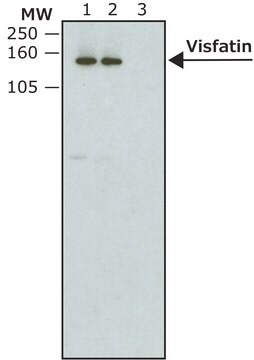일반 설명
We are committed to bringing you greener alternative products, which adhere to one or more of The 12 Principles of Green Chemistry.This antibody is Preservative-free, produced without the harm or sacrifice of animals and exceptionally stable to allow for ambient shipping and storage if needed and thus aligns with "Waste Prevention", "Designing Safer Chemicals" and "Design for Energy Efficiency".
Click here for more information.
ZooMAb® antibodies represent an entirely new generation of recombinant monoclonal antibodies.Each ZooMAb® antibody is manufactured using our proprietary recombinant expression system, purified to homogeneity, and precisely dispensed to produce robust and highly reproducible lot-to-lot consistency. Only top-performing clones are released for use by researchers. Each antibody is validated for high specificity and affinity across multiple applications, including its most commonly used application. ZooMAb® antibodies are reliably available and ready to ship when you need them.
특이성
Clone 1E21 is a ZooMAb® Rabbit recombinant monoclonal antibody that specifically detects Phosphorylated CTD-interacting factor 1 (PCIF1). It targets an epitope within 20 amino acids from the C-terminal region.
면역원
KLH-conjugated linear peptide corresponding to 20 amino acids from the C-terminal region of human Phosphorylated CTD-interacting factor 1 (PCIF1).
애플리케이션
Quality Control Testing
Evaluated by Western Blotting with recombinant human PCIF1 Protein.
Western Blotting Analysis: A 1:1,000 dilution of this antibody detected recombinant human PCIF1 protein.
Tested applications
Western Blotting Analysis: A 1:1,000 dilution from a representative lot detected PCIF1 in HeLa cell nuclear extract.
Enzyme Immunoassay Analysis (ELISA): A representative lot of this antibody detected recombinant human PCIF1 protein in ELISA application.
Immunohistochemistry (Paraffin) Analysis: A 1:1,000 dilution from a representative lot detected PCIF1 in human fallopian tube.
Affinity Binding Assay: A representative lot of this antibody bound PCIF1 peptide with a KD of 5.2 x 10-7 in an affinity binding assay.
Note: Actual optimal working dilutions must be determined by end user as specimens, and experimental conditions may vary with the end user
표적 설명
mRNA (2′-O-methyladenosine-N(6)-)-methyltransferase (UniProt: Q9H4Z3; also known as EC:2.1.1.62, Cap-specific adenosine methyltransferase, CAPAM, hCAPAM, Phosphorylated CTD-interacting factor 1, hPCIF1, Protein phosphatase 1 regulatory subunit 121) is encoded by the PCIF1 (also known as C20orf67, CAPAM, PPP1R121) gene (Gene ID: 63935) in human. PCIF1 is a ubiquitously expressed, evolutionarily conserved protein with Cap-specific adenosine methyltransferase activity. It catalyzes the formation of N6,2′-O-dimethyladenosine cap (m6A(m)) by methylating the adenosine at the second transcribed position of capped mRNAs. It is reported to catalyzes only 5′ m6Am methylation of capped mRNAs but not internal m6A methylation in vitro and in vivo. N6-methyladenosine (m6A) is a major modification of messenger RNAs that plays a critical role in RNA metabolism and function. It plays key regulatory role in cell differentiation, neuronal function, and cancer cell proliferation. PCIF1 is recruited to the early elongation complex of RNA polymerase II (RNAPII) via interaction with the C-terminal serine phosphorylated domain and mediates formation of m6A(m) co-transcriptionally. It contains a WW domain (aa 43-77) in its N-terminal region that is reported to be sufficient for direct and specific interaction with the phosphorylated C-terminal domain of RNAPII. It has two nuclear localization signals that are located in amino acids 109-113 and 669-684. This ZooMAbZooMAb® recombinant monoclonal antibody, generated by our propriety technology, offers significantly enhanced specificity, affinity, reproducibility, and stability over conventional monoclonals. (Ref.: Akichika, S., et al. (2019). Science. 363(6423); Sendinc, E., et al. (2019). Mol. Cell. 75(3); 620-630).
물리적 형태
Purified recombinant rabbit monoclonal antibody IgG, lyophilized in PBS, 5% Trehalose, normal appearance a coarse or translucent resin. The PBS/trehalose components in the ZooMAb formulation can have the appearance of a semi-solid (bead like gel) after lyophilization. This is a normal phenomenon. Please follow the recommended reconstitution procedure in the data sheet to dissolve the semi-solid, bead-like, gel-appearing material. The resulting antibody solution is completely stable and functional as proven by full functional testing. Contains no biocide or preservatives, such as azide, or any animal by-products. Larger pack sizes provided as multiples of 25 μL.
재구성
300 μg/mL after reconstitution at 25 μL per vial. Please refer to guidance on suggested starting dilutions and/or titers per application and sample type.
저장 및 안정성
Recommend storage of lyophilized product at 2-8°C; Before reconstitution, micro-centrifuge vials briefly to spin down material to bottom of the vial; Reconstitute each vial by adding 25 μL of filtered lab grade water or PBS; Reconstituted antibodies can be stored at 2-8°C, or -20°C for long term storage. Avoid repeated freeze-thaws.
법적 정보
ZooMAb is a registered trademark of Merck KGaA, Darmstadt, Germany
면책조항
Unless otherwise stated in our catalog or other company documentation accompanying the product(s), our products are intended for research use only and are not to be used for any other purpose, which includes but is not limited to, unauthorized commercial uses, in vitro diagnostic uses, ex vivo or in vivo therapeutic uses or any type of consumption or application to humans or animals.








